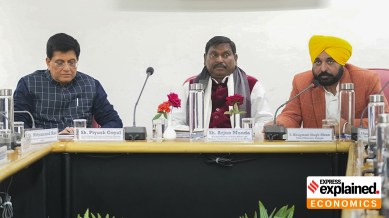Food Minister Piyush Goyal told reporters that under the “very innovative, out-of-the-box idea”, the National Cooperative Consumers’ Federation of India Ltd (NCCF), the National Agricultural Cooperative Marketing Federation of India Ltd (NAFED), and the Cotton Corporation of India (CCI) would buy these crops with “no limit on the quantity”.
On Monday evening, the farmers, who have demanded a legally guaranteed MSP for all crops across the country and determination of crop prices as per the report of the Dr Swaminathan Commission, rejected the Centre’s proposal.
The Dilli Chalo protest march will resume at 11 am on Wednesday, they said.
Why is the Centre pushing for crop diversification in Punjab?
More than 80% of the geographical area of Punjab (41.17 lakh hectares out of 50.33 lakh hectares), is under cultivation, mostly under rice and wheat. In 2019-20, as much as 35.21 lakh hectares out of the net sown area of 41.17 lakh hectares was under wheat, and 31.42 lakh hectares was under paddy.
The crops in the Centre’s proposal had very small shares in comparison: 2.48 lakh hectares for cotton, 1.14 lakh hectares for maize, and 33,000 hectares for pulses (both kharif and rabi) in 2019-20.
Paddy is a guzzler of water — about 2,500 litres (through irrigation or rainfall) is needed to produce 1 kg of rice — and its cultivation has led to massive and indiscriminate withdrawal of groundwater in the state, which now stares at widespread desertification.
Story continues below this ad
Attempts at diversification of cropping patterns have not yielded the desired results. The area under cotton came down from 2.91 lakh hectares in 2017-18 to 2.51 lakh hectares in 2021-22, and the area under maize (which is a kharif crop in Punjab) came down from 1.14 lakh hectares to 1.05 lakh hectares in the same period.
The area under pulses, however, rose from 30,2000 hectares in 2017-18 to 62,600 hectares in 2021-22.
Which states are the major producers of the three pulses in the government’s proposal?
Just a handful of states account for half of the country’s total production of pulses.
Madhya Pradesh, West Bengal, Bihar, and Jharkhand produce 95% of India’s masur; Maharashtra, Karnataka, Uttar Pradesh, Gujarat and Jharkhand produce 80% of arhar (tur); and Madhya Pradesh, Andhra Pradesh, Uttar Pradesh, Tamil Nadu and Maharashtra produce 75% of urad.
Story continues below this ad
India is dependent on imports of pulses to meet its domestic demand. Total production in 2021-22 was only 27.69 million tonnes.
The government has set a target of becoming self-sufficient in pulses by 2027, and has been promoting their production through incentives (in terms of higher MSP), and procurement through initiatives like the Price Support Scheme (PSS) and Price Stabilisation Fund (PSF).
How much pulses and cotton does the government procure?
The Centre announces MSP for 22 crops, but procurement is limited to only a few crops. The Food Corporation of India (FCI) procures cereals, especially wheat and paddy; NAFED mainly procures pulses and oilseeds; and CCI is the procurement agency for cotton.
COTTON: Official data show that the procurement of cotton by CCI in Punjab has been rising in the last three years; the overall figures however, are still very low. Punjab accounts for about 5% of the total cotton procurement by the CCI in the country.
Story continues below this ad
Figures available with the Ministry of Agriculture and Farmers Welfare show the CCI procured a total 91.90 lakh bales (each bale equals 170 kg) during 2021-22, out of which the largest share of 34.01 lakh bales came from Andhra Pradesh. The figure for Punjab was just 5.36 lakh bales in 2021-22, which was, however, more than the 3.58 lakh bales in 2020-21.
PULSES: In 2022-23, NAFED procured 29.64 lakh tonnes of pulses at the MSP under PSS, (benefiting 13.77 lakh farmers), and 57,754 tonnes under PSF. Of the total quantity procured by NAFED, the largest share (84.59 lakh tonnes) was of gram, followed by moong (12.59 lakh tonnes).
The Commission for Agricultural Costs and Prices (CACP), the body that recommends the MSPs for various crops, has raised questions about the procurement of pulses by NAFED.
In its report, Price Policy for Rabi Crops Marketing Season 2024-25, the CACP noted: “Due to record production of gram and depressed market prices during the last two seasons, Government procured about 25.6 lakh tonnes of gram during RMS2022-23 and 22.3 lakh tonnes (as on 1 June 2023) in RMS2023-24 under Price Support Scheme (PSS). Total procurement of pulses increased from about 29.6 lakh tonnes in 2021-22 (KMS2021-22 and RMS2022-23) to about 30.2 lakh tonnes in 2022-23… [But] since there is no assured mechanism for disposal of pulses procured under the PSS,…NAFED disposes of the stock of pulses in open market at a price much lower than the MSP.”
Story continues below this ad
For instance, the CACP said, average disposal rate of gram procured under PSS was Rs 4,646 per quintal during 2022-23, which was much lower than the MSP. “The sale of pulses in open market below the MSP adversely affects the market prices and discourages traders to procure directly from farmers,” the CACP report said.
It expressed the view that “distribution of pulses to households in the aspirational districts would help in improving nutrition in these areas and disposal of stocks without affecting the market prices… Liquidation of stocks of pulses procured under PSS by NAFED continues to remain a challenge as NAFED incurs losses in the open market operations.”
